Analysis of Yield Curve and Share Prices of AMP and Qantas
VerifiedAdded on 2023/06/05
|11
|1444
|217
AI Summary
This report analyzes the past performance and future prospects of AMP and Qantas shares based on yield curve and share prices analysis. It includes an analysis of the yield curve, monthly returns, beta, and CAPM model. The report also provides an overview of the companies and their current market conditions.
Contribute Materials
Your contribution can guide someone’s learning journey. Share your
documents today.
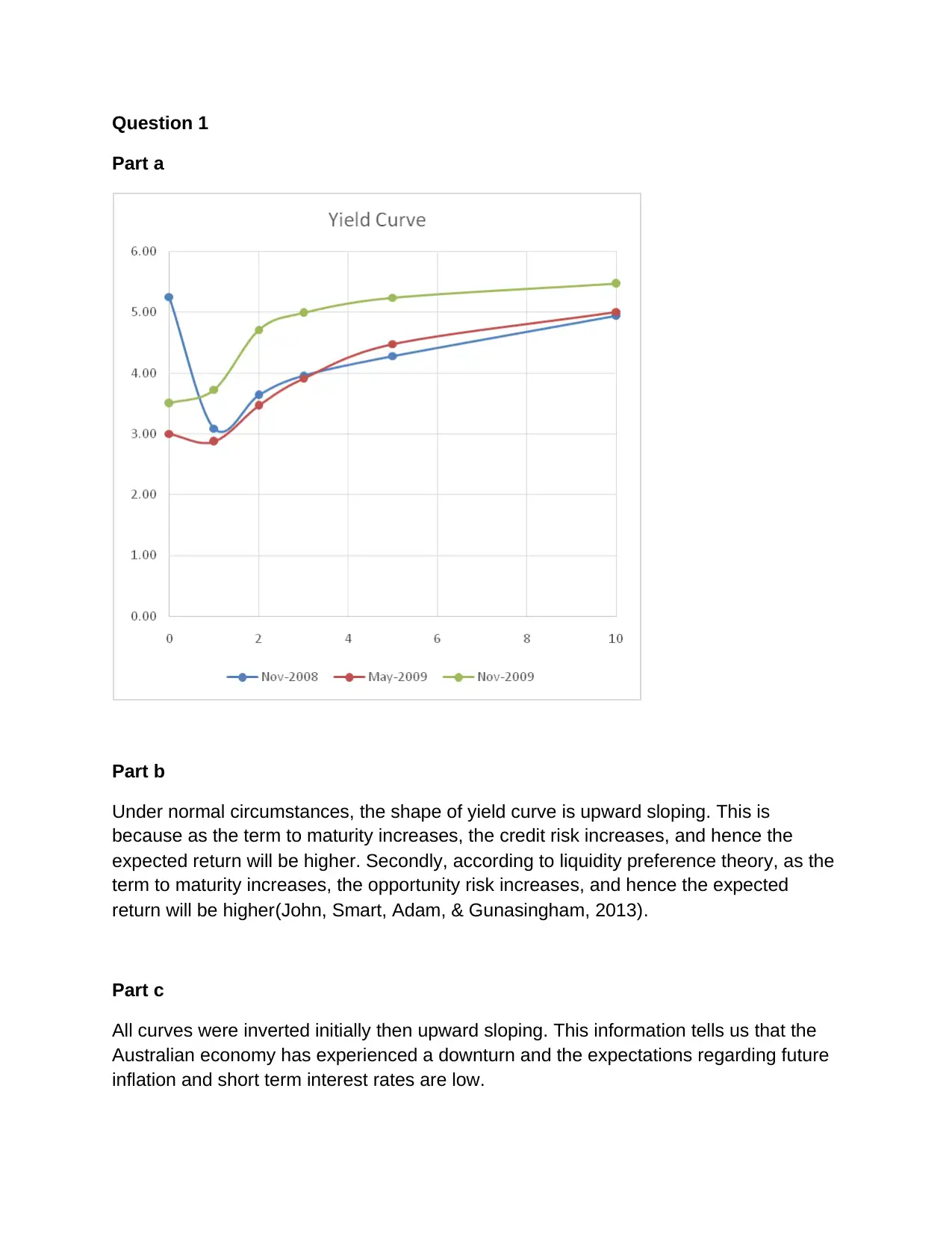
Question 1
Part a
Part b
Under normal circumstances, the shape of yield curve is upward sloping. This is
because as the term to maturity increases, the credit risk increases, and hence the
expected return will be higher. Secondly, according to liquidity preference theory, as the
term to maturity increases, the opportunity risk increases, and hence the expected
return will be higher(John, Smart, Adam, & Gunasingham, 2013).
Part c
All curves were inverted initially then upward sloping. This information tells us that the
Australian economy has experienced a downturn and the expectations regarding future
inflation and short term interest rates are low.
Part a
Part b
Under normal circumstances, the shape of yield curve is upward sloping. This is
because as the term to maturity increases, the credit risk increases, and hence the
expected return will be higher. Secondly, according to liquidity preference theory, as the
term to maturity increases, the opportunity risk increases, and hence the expected
return will be higher(John, Smart, Adam, & Gunasingham, 2013).
Part c
All curves were inverted initially then upward sloping. This information tells us that the
Australian economy has experienced a downturn and the expectations regarding future
inflation and short term interest rates are low.
Secure Best Marks with AI Grader
Need help grading? Try our AI Grader for instant feedback on your assignments.
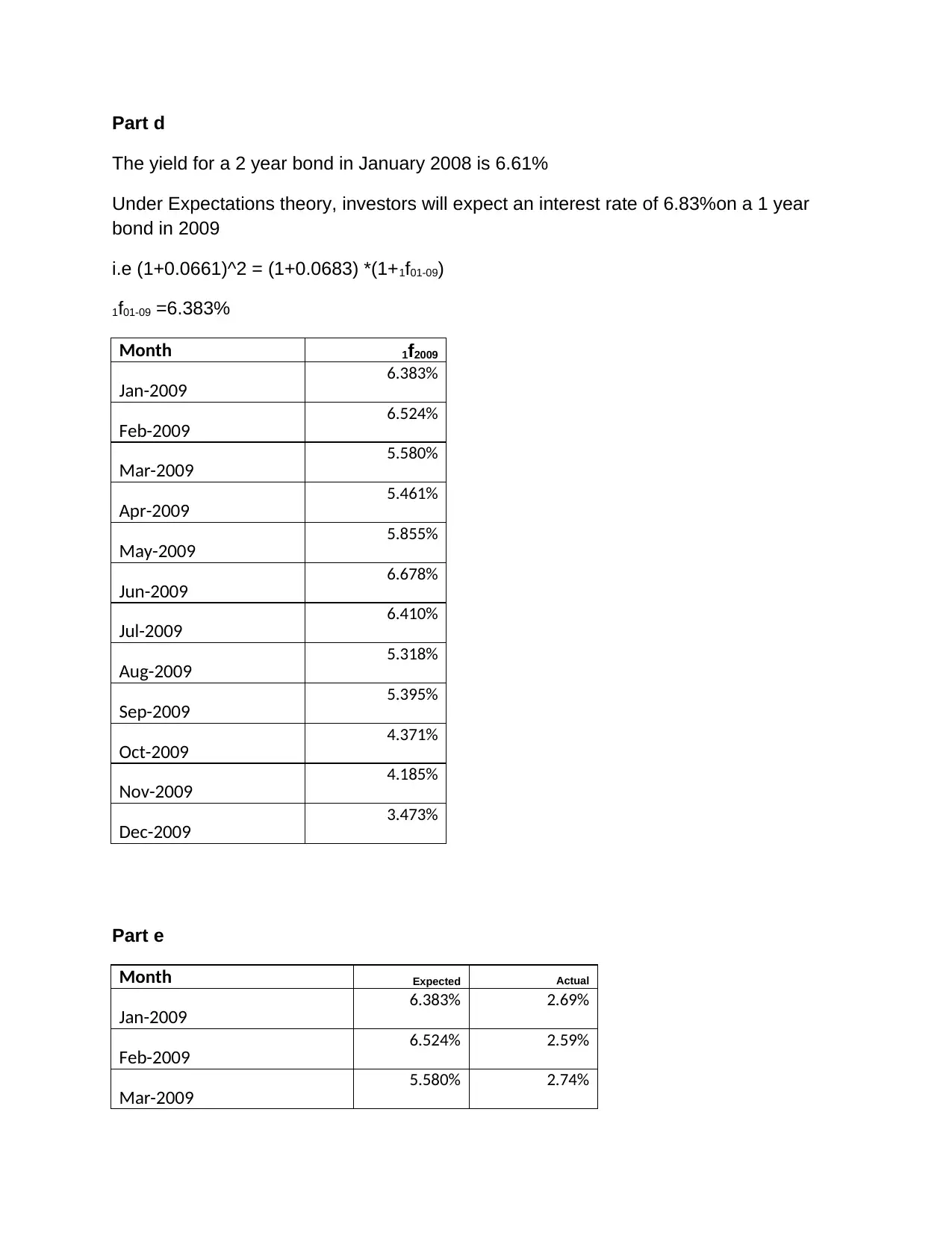
Part d
The yield for a 2 year bond in January 2008 is 6.61%
Under Expectations theory, investors will expect an interest rate of 6.83%on a 1 year
bond in 2009
i.e (1+0.0661)^2 = (1+0.0683) *(1+1f01-09)
1f01-09 =6.383%
Month 1f2009
Jan-2009 6.383%
Feb-2009 6.524%
Mar-2009 5.580%
Apr-2009 5.461%
May-2009 5.855%
Jun-2009 6.678%
Jul-2009 6.410%
Aug-2009 5.318%
Sep-2009 5.395%
Oct-2009 4.371%
Nov-2009 4.185%
Dec-2009 3.473%
Part e
Month Expected Actual
Jan-2009 6.383% 2.69%
Feb-2009 6.524% 2.59%
Mar-2009 5.580% 2.74%
The yield for a 2 year bond in January 2008 is 6.61%
Under Expectations theory, investors will expect an interest rate of 6.83%on a 1 year
bond in 2009
i.e (1+0.0661)^2 = (1+0.0683) *(1+1f01-09)
1f01-09 =6.383%
Month 1f2009
Jan-2009 6.383%
Feb-2009 6.524%
Mar-2009 5.580%
Apr-2009 5.461%
May-2009 5.855%
Jun-2009 6.678%
Jul-2009 6.410%
Aug-2009 5.318%
Sep-2009 5.395%
Oct-2009 4.371%
Nov-2009 4.185%
Dec-2009 3.473%
Part e
Month Expected Actual
Jan-2009 6.383% 2.69%
Feb-2009 6.524% 2.59%
Mar-2009 5.580% 2.74%
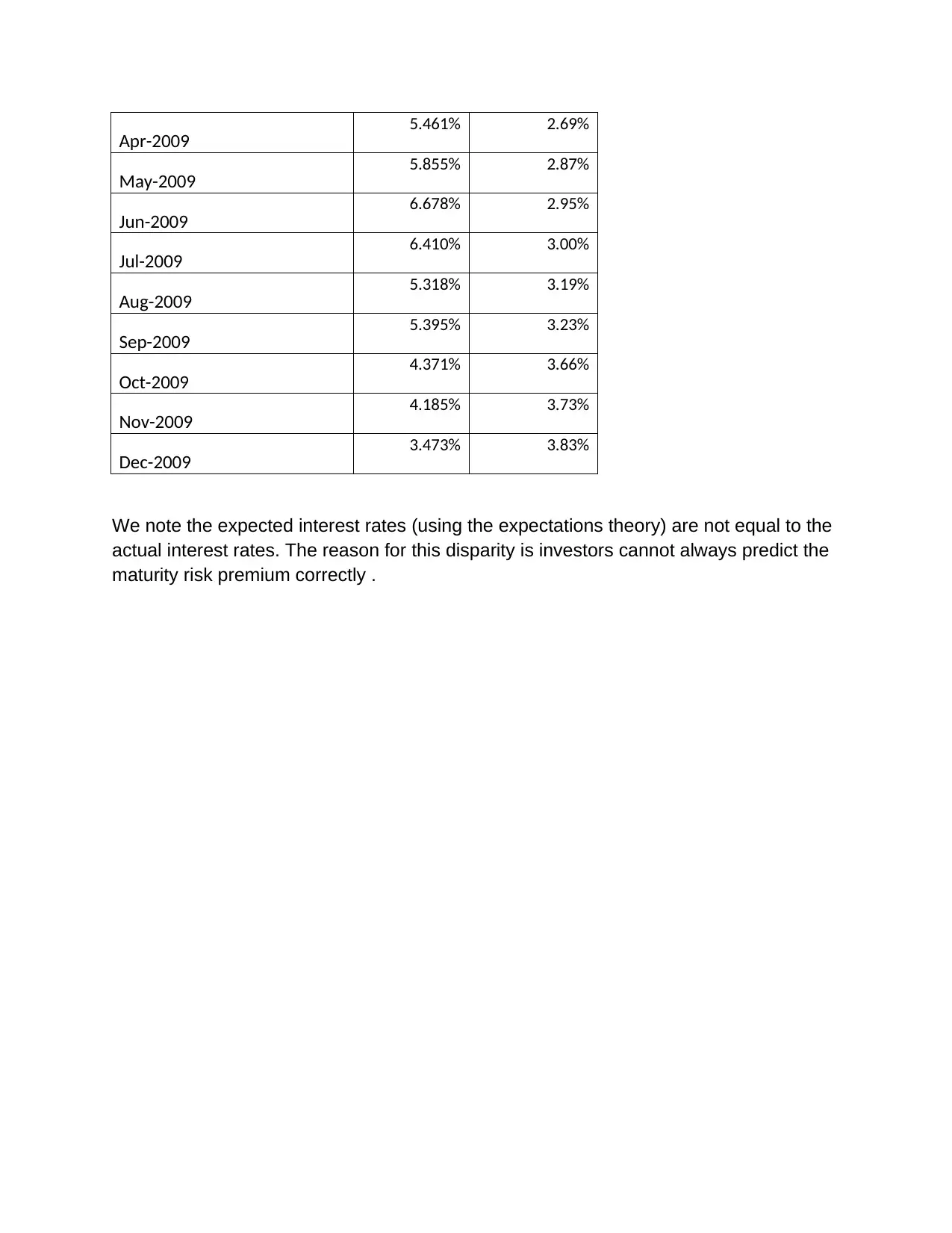
Apr-2009 5.461% 2.69%
May-2009 5.855% 2.87%
Jun-2009 6.678% 2.95%
Jul-2009 6.410% 3.00%
Aug-2009 5.318% 3.19%
Sep-2009 5.395% 3.23%
Oct-2009 4.371% 3.66%
Nov-2009 4.185% 3.73%
Dec-2009 3.473% 3.83%
We note the expected interest rates (using the expectations theory) are not equal to the
actual interest rates. The reason for this disparity is investors cannot always predict the
maturity risk premium correctly .
May-2009 5.855% 2.87%
Jun-2009 6.678% 2.95%
Jul-2009 6.410% 3.00%
Aug-2009 5.318% 3.19%
Sep-2009 5.395% 3.23%
Oct-2009 4.371% 3.66%
Nov-2009 4.185% 3.73%
Dec-2009 3.473% 3.83%
We note the expected interest rates (using the expectations theory) are not equal to the
actual interest rates. The reason for this disparity is investors cannot always predict the
maturity risk premium correctly .
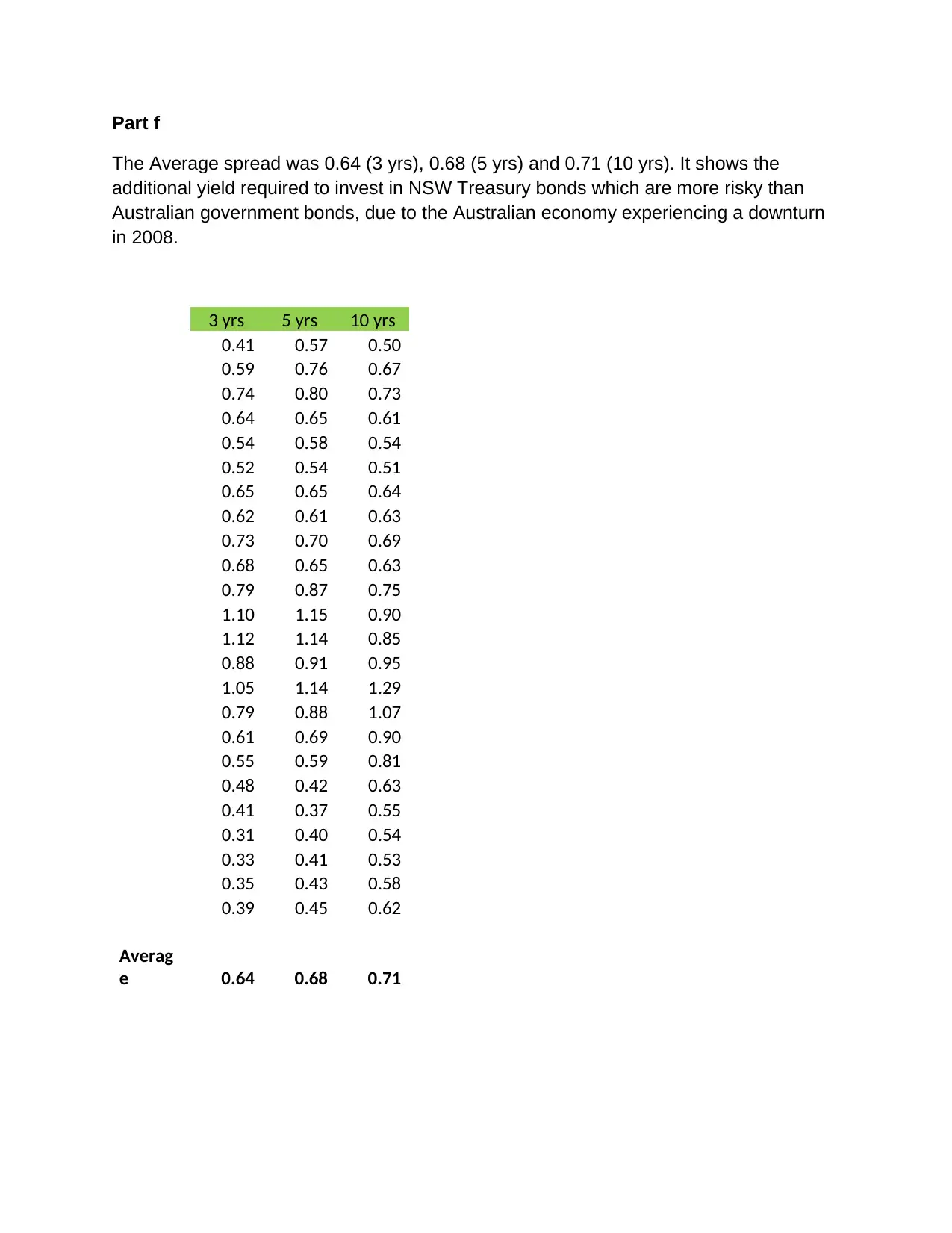
Part f
The Average spread was 0.64 (3 yrs), 0.68 (5 yrs) and 0.71 (10 yrs). It shows the
additional yield required to invest in NSW Treasury bonds which are more risky than
Australian government bonds, due to the Australian economy experiencing a downturn
in 2008.
3 yrs 5 yrs 10 yrs
0.41 0.57 0.50
0.59 0.76 0.67
0.74 0.80 0.73
0.64 0.65 0.61
0.54 0.58 0.54
0.52 0.54 0.51
0.65 0.65 0.64
0.62 0.61 0.63
0.73 0.70 0.69
0.68 0.65 0.63
0.79 0.87 0.75
1.10 1.15 0.90
1.12 1.14 0.85
0.88 0.91 0.95
1.05 1.14 1.29
0.79 0.88 1.07
0.61 0.69 0.90
0.55 0.59 0.81
0.48 0.42 0.63
0.41 0.37 0.55
0.31 0.40 0.54
0.33 0.41 0.53
0.35 0.43 0.58
0.39 0.45 0.62
Averag
e 0.64 0.68 0.71
The Average spread was 0.64 (3 yrs), 0.68 (5 yrs) and 0.71 (10 yrs). It shows the
additional yield required to invest in NSW Treasury bonds which are more risky than
Australian government bonds, due to the Australian economy experiencing a downturn
in 2008.
3 yrs 5 yrs 10 yrs
0.41 0.57 0.50
0.59 0.76 0.67
0.74 0.80 0.73
0.64 0.65 0.61
0.54 0.58 0.54
0.52 0.54 0.51
0.65 0.65 0.64
0.62 0.61 0.63
0.73 0.70 0.69
0.68 0.65 0.63
0.79 0.87 0.75
1.10 1.15 0.90
1.12 1.14 0.85
0.88 0.91 0.95
1.05 1.14 1.29
0.79 0.88 1.07
0.61 0.69 0.90
0.55 0.59 0.81
0.48 0.42 0.63
0.41 0.37 0.55
0.31 0.40 0.54
0.33 0.41 0.53
0.35 0.43 0.58
0.39 0.45 0.62
Averag
e 0.64 0.68 0.71
Secure Best Marks with AI Grader
Need help grading? Try our AI Grader for instant feedback on your assignments.
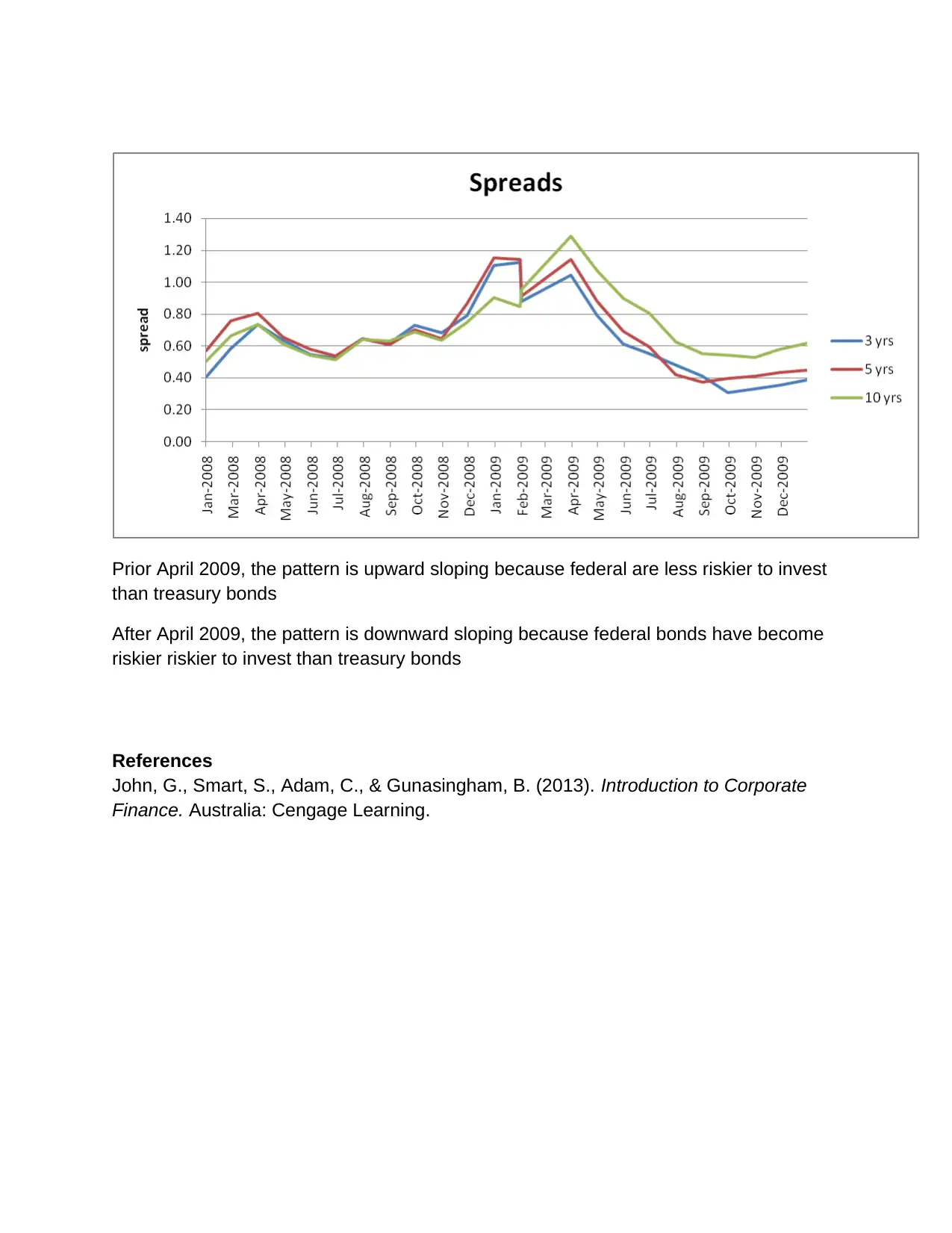
Prior April 2009, the pattern is upward sloping because federal are less riskier to invest
than treasury bonds
After April 2009, the pattern is downward sloping because federal bonds have become
riskier riskier to invest than treasury bonds
References
John, G., Smart, S., Adam, C., & Gunasingham, B. (2013). Introduction to Corporate
Finance. Australia: Cengage Learning.
than treasury bonds
After April 2009, the pattern is downward sloping because federal bonds have become
riskier riskier to invest than treasury bonds
References
John, G., Smart, S., Adam, C., & Gunasingham, B. (2013). Introduction to Corporate
Finance. Australia: Cengage Learning.
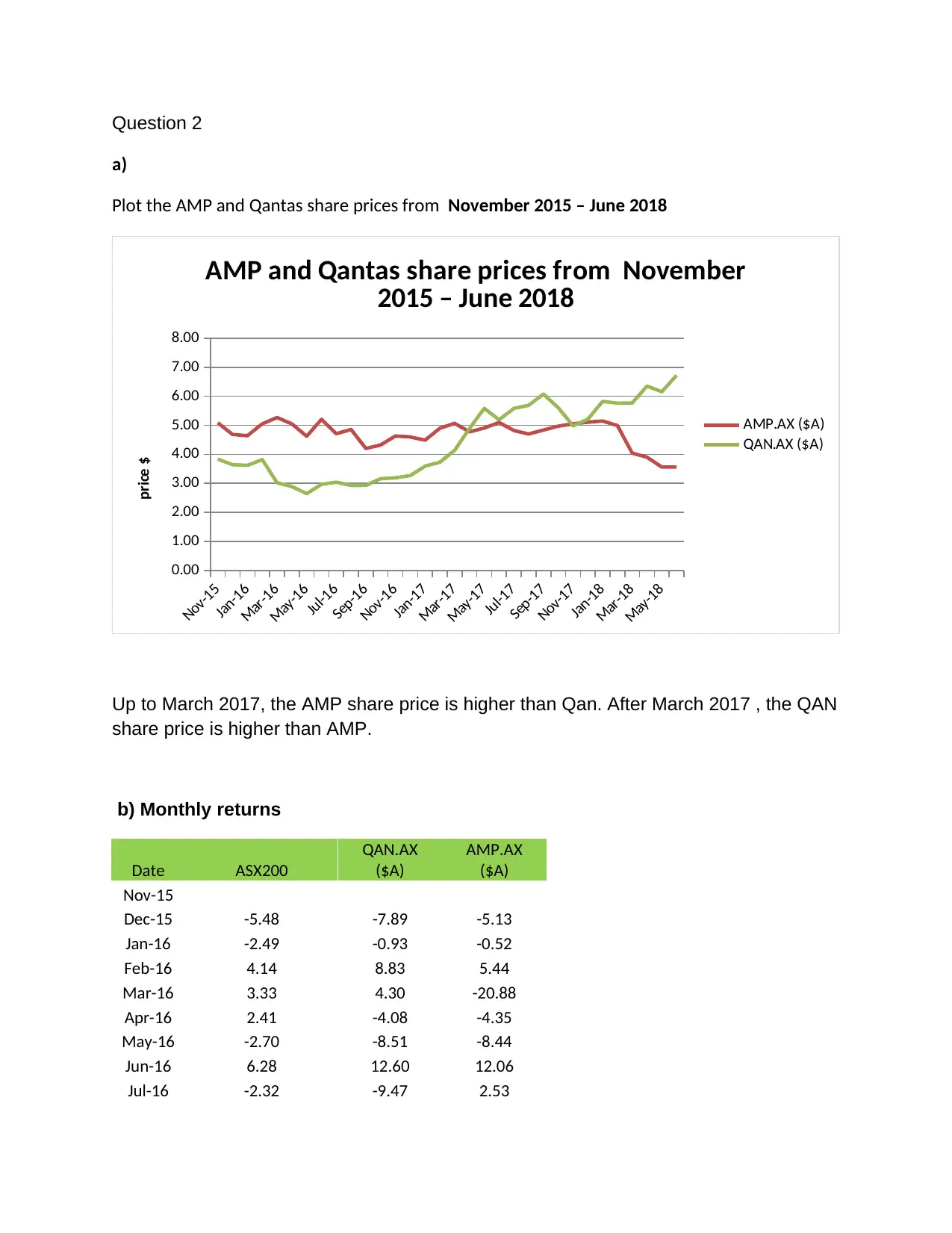
Question 2
a)
Plot the AMP and Qantas share prices from November 2015 – June 2018
Nov-15
Jan-16
Mar-16
May-16
Jul-16
Sep-16
Nov-16
Jan-17
Mar-17
May-17
Jul-17
Sep-17
Nov-17
Jan-18
Mar-18
May-18
0.00
1.00
2.00
3.00
4.00
5.00
6.00
7.00
8.00
AMP and Qantas share prices from November
2015 – June 2018
AMP.AX ($A)
QAN.AX ($A)
price $
Up to March 2017, the AMP share price is higher than Qan. After March 2017 , the QAN
share price is higher than AMP.
b) Monthly returns
Date ASX200
QAN.AX
($A)
AMP.AX
($A)
Nov-15
Dec-15 -5.48 -7.89 -5.13
Jan-16 -2.49 -0.93 -0.52
Feb-16 4.14 8.83 5.44
Mar-16 3.33 4.30 -20.88
Apr-16 2.41 -4.08 -4.35
May-16 -2.70 -8.51 -8.44
Jun-16 6.28 12.60 12.06
Jul-16 -2.32 -9.47 2.53
a)
Plot the AMP and Qantas share prices from November 2015 – June 2018
Nov-15
Jan-16
Mar-16
May-16
Jul-16
Sep-16
Nov-16
Jan-17
Mar-17
May-17
Jul-17
Sep-17
Nov-17
Jan-18
Mar-18
May-18
0.00
1.00
2.00
3.00
4.00
5.00
6.00
7.00
8.00
AMP and Qantas share prices from November
2015 – June 2018
AMP.AX ($A)
QAN.AX ($A)
price $
Up to March 2017, the AMP share price is higher than Qan. After March 2017 , the QAN
share price is higher than AMP.
b) Monthly returns
Date ASX200
QAN.AX
($A)
AMP.AX
($A)
Nov-15
Dec-15 -5.48 -7.89 -5.13
Jan-16 -2.49 -0.93 -0.52
Feb-16 4.14 8.83 5.44
Mar-16 3.33 4.30 -20.88
Apr-16 2.41 -4.08 -4.35
May-16 -2.70 -8.51 -8.44
Jun-16 6.28 12.60 12.06
Jul-16 -2.32 -9.47 2.53
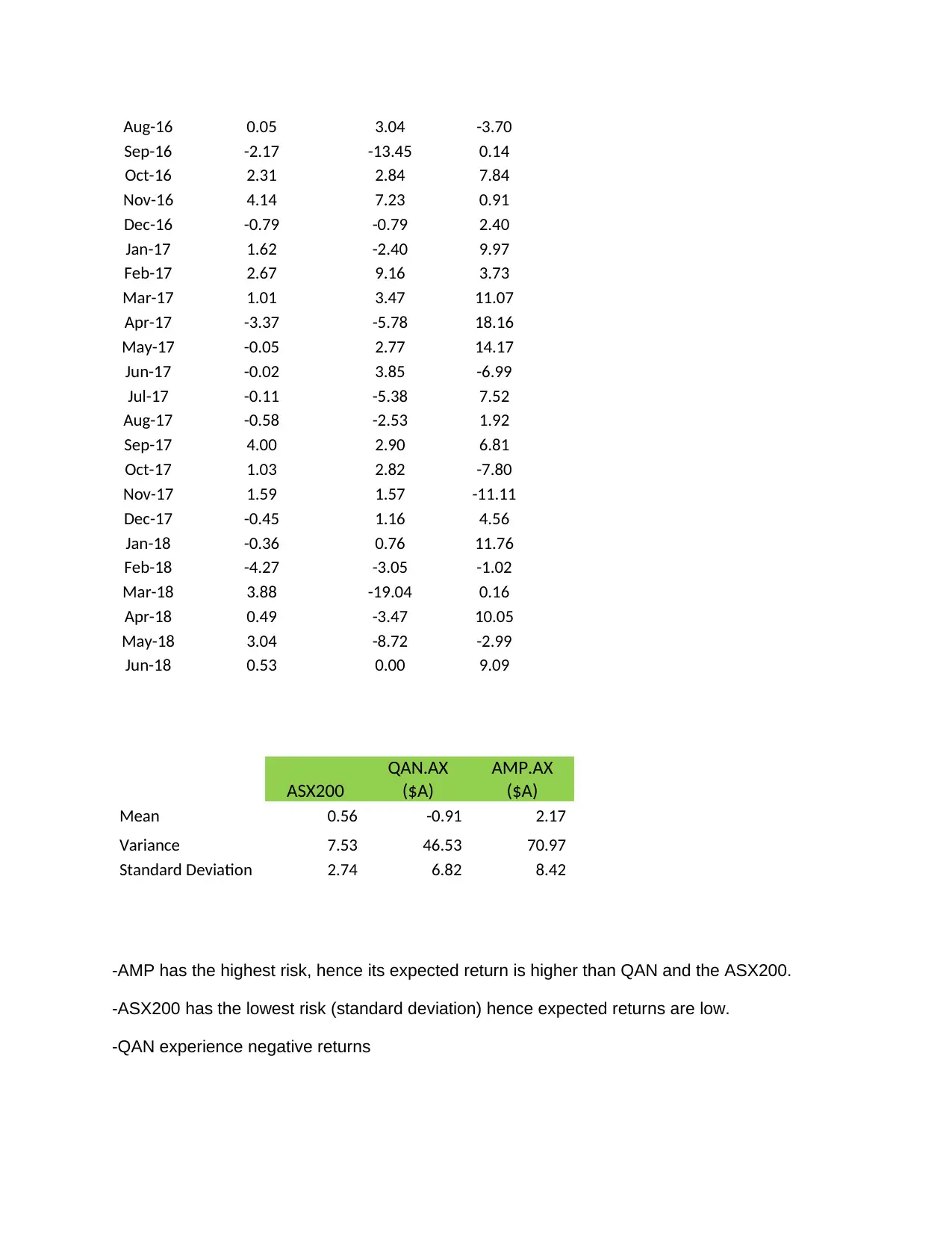
Aug-16 0.05 3.04 -3.70
Sep-16 -2.17 -13.45 0.14
Oct-16 2.31 2.84 7.84
Nov-16 4.14 7.23 0.91
Dec-16 -0.79 -0.79 2.40
Jan-17 1.62 -2.40 9.97
Feb-17 2.67 9.16 3.73
Mar-17 1.01 3.47 11.07
Apr-17 -3.37 -5.78 18.16
May-17 -0.05 2.77 14.17
Jun-17 -0.02 3.85 -6.99
Jul-17 -0.11 -5.38 7.52
Aug-17 -0.58 -2.53 1.92
Sep-17 4.00 2.90 6.81
Oct-17 1.03 2.82 -7.80
Nov-17 1.59 1.57 -11.11
Dec-17 -0.45 1.16 4.56
Jan-18 -0.36 0.76 11.76
Feb-18 -4.27 -3.05 -1.02
Mar-18 3.88 -19.04 0.16
Apr-18 0.49 -3.47 10.05
May-18 3.04 -8.72 -2.99
Jun-18 0.53 0.00 9.09
ASX200
QAN.AX
($A)
AMP.AX
($A)
Mean 0.56 -0.91 2.17
Variance 7.53 46.53 70.97
Standard Deviation 2.74 6.82 8.42
-AMP has the highest risk, hence its expected return is higher than QAN and the ASX200.
-ASX200 has the lowest risk (standard deviation) hence expected returns are low.
-QAN experience negative returns
Sep-16 -2.17 -13.45 0.14
Oct-16 2.31 2.84 7.84
Nov-16 4.14 7.23 0.91
Dec-16 -0.79 -0.79 2.40
Jan-17 1.62 -2.40 9.97
Feb-17 2.67 9.16 3.73
Mar-17 1.01 3.47 11.07
Apr-17 -3.37 -5.78 18.16
May-17 -0.05 2.77 14.17
Jun-17 -0.02 3.85 -6.99
Jul-17 -0.11 -5.38 7.52
Aug-17 -0.58 -2.53 1.92
Sep-17 4.00 2.90 6.81
Oct-17 1.03 2.82 -7.80
Nov-17 1.59 1.57 -11.11
Dec-17 -0.45 1.16 4.56
Jan-18 -0.36 0.76 11.76
Feb-18 -4.27 -3.05 -1.02
Mar-18 3.88 -19.04 0.16
Apr-18 0.49 -3.47 10.05
May-18 3.04 -8.72 -2.99
Jun-18 0.53 0.00 9.09
ASX200
QAN.AX
($A)
AMP.AX
($A)
Mean 0.56 -0.91 2.17
Variance 7.53 46.53 70.97
Standard Deviation 2.74 6.82 8.42
-AMP has the highest risk, hence its expected return is higher than QAN and the ASX200.
-ASX200 has the lowest risk (standard deviation) hence expected returns are low.
-QAN experience negative returns
Paraphrase This Document
Need a fresh take? Get an instant paraphrase of this document with our AI Paraphraser

c) Beta
ASX200 QAN.AX ($A) AMP.AX ($A)
Mean 0.56 -0.91 2.17
Variance 7.53 46.53 70.97
Standard Deviation 2.74 6.82 8.42
Covariance 8.57 0.67
Beta 1.1380 0.0887
d)
QAN has a Beta higher than 1 indicating that it is more volatile than the market, hence it is able
to achieve returns greater than the market.
AMP has a Beta lower than 1 indicating that it is less volatile than the market
e)
CAPM model
Re = rf +β(rm –rf)
Where rf = Risk freerate, β= Beta, (rm –rf)= Risk premium
If expected return CAPM> Investors Return, share is overpriced. If expected return
CAPM < Investors Return, share is underpriced
AMP Re = 0.14% +0.0887*(0.56% – 0.14%)
=0.18
Since 0.18<2.17, AMP share is underpriced
QAN Re = 0.14% +1.1380*(0.56% – 0.14%)
ASX200 QAN.AX ($A) AMP.AX ($A)
Mean 0.56 -0.91 2.17
Variance 7.53 46.53 70.97
Standard Deviation 2.74 6.82 8.42
Covariance 8.57 0.67
Beta 1.1380 0.0887
d)
QAN has a Beta higher than 1 indicating that it is more volatile than the market, hence it is able
to achieve returns greater than the market.
AMP has a Beta lower than 1 indicating that it is less volatile than the market
e)
CAPM model
Re = rf +β(rm –rf)
Where rf = Risk freerate, β= Beta, (rm –rf)= Risk premium
If expected return CAPM> Investors Return, share is overpriced. If expected return
CAPM < Investors Return, share is underpriced
AMP Re = 0.14% +0.0887*(0.56% – 0.14%)
=0.18
Since 0.18<2.17, AMP share is underpriced
QAN Re = 0.14% +1.1380*(0.56% – 0.14%)

=0.62
Since 0.62 >-0.091, QAN share is overpriced
Since 0.62 >-0.091, QAN share is overpriced
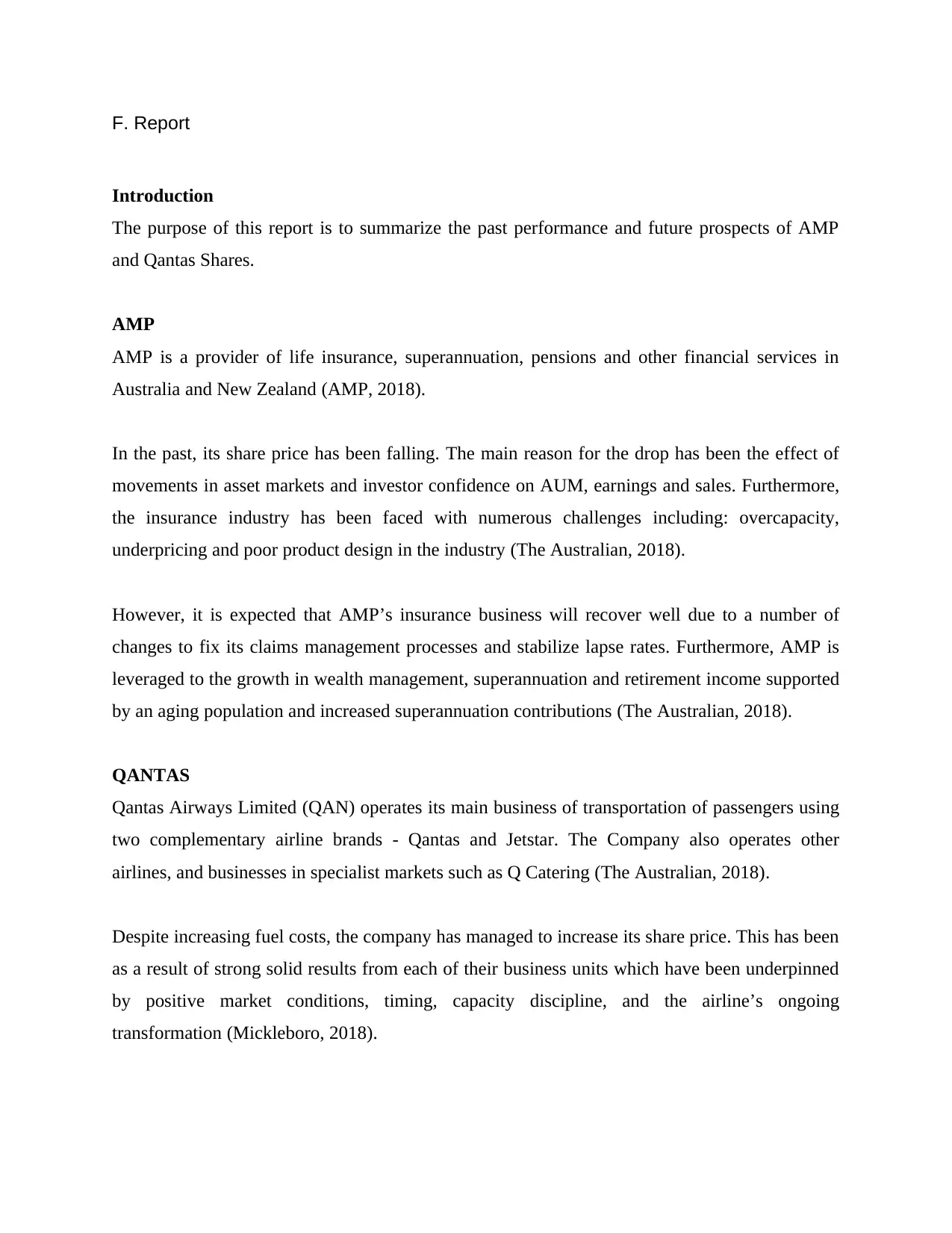
F. Report
Introduction
The purpose of this report is to summarize the past performance and future prospects of AMP
and Qantas Shares.
AMP
AMP is a provider of life insurance, superannuation, pensions and other financial services in
Australia and New Zealand (AMP, 2018).
In the past, its share price has been falling. The main reason for the drop has been the effect of
movements in asset markets and investor confidence on AUM, earnings and sales. Furthermore,
the insurance industry has been faced with numerous challenges including: overcapacity,
underpricing and poor product design in the industry (The Australian, 2018).
However, it is expected that AMP’s insurance business will recover well due to a number of
changes to fix its claims management processes and stabilize lapse rates. Furthermore, AMP is
leveraged to the growth in wealth management, superannuation and retirement income supported
by an aging population and increased superannuation contributions (The Australian, 2018).
QANTAS
Qantas Airways Limited (QAN) operates its main business of transportation of passengers using
two complementary airline brands - Qantas and Jetstar. The Company also operates other
airlines, and businesses in specialist markets such as Q Catering (The Australian, 2018).
Despite increasing fuel costs, the company has managed to increase its share price. This has been
as a result of strong solid results from each of their business units which have been underpinned
by positive market conditions, timing, capacity discipline, and the airline’s ongoing
transformation (Mickleboro, 2018).
Introduction
The purpose of this report is to summarize the past performance and future prospects of AMP
and Qantas Shares.
AMP
AMP is a provider of life insurance, superannuation, pensions and other financial services in
Australia and New Zealand (AMP, 2018).
In the past, its share price has been falling. The main reason for the drop has been the effect of
movements in asset markets and investor confidence on AUM, earnings and sales. Furthermore,
the insurance industry has been faced with numerous challenges including: overcapacity,
underpricing and poor product design in the industry (The Australian, 2018).
However, it is expected that AMP’s insurance business will recover well due to a number of
changes to fix its claims management processes and stabilize lapse rates. Furthermore, AMP is
leveraged to the growth in wealth management, superannuation and retirement income supported
by an aging population and increased superannuation contributions (The Australian, 2018).
QANTAS
Qantas Airways Limited (QAN) operates its main business of transportation of passengers using
two complementary airline brands - Qantas and Jetstar. The Company also operates other
airlines, and businesses in specialist markets such as Q Catering (The Australian, 2018).
Despite increasing fuel costs, the company has managed to increase its share price. This has been
as a result of strong solid results from each of their business units which have been underpinned
by positive market conditions, timing, capacity discipline, and the airline’s ongoing
transformation (Mickleboro, 2018).
Secure Best Marks with AI Grader
Need help grading? Try our AI Grader for instant feedback on your assignments.
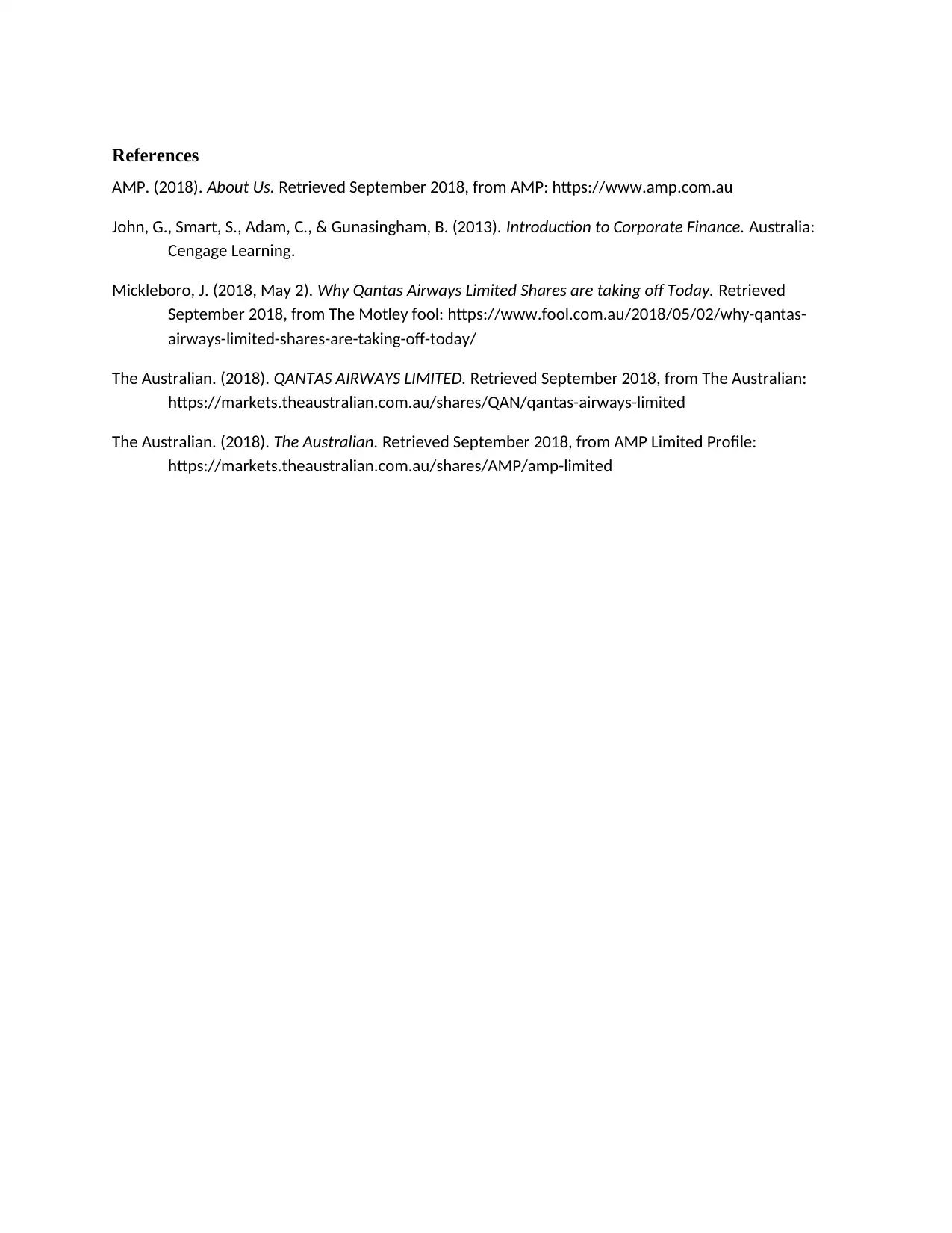
References
AMP. (2018). About Us. Retrieved September 2018, from AMP: https://www.amp.com.au
John, G., Smart, S., Adam, C., & Gunasingham, B. (2013). Introduction to Corporate Finance. Australia:
Cengage Learning.
Mickleboro, J. (2018, May 2). Why Qantas Airways Limited Shares are taking off Today. Retrieved
September 2018, from The Motley fool: https://www.fool.com.au/2018/05/02/why-qantas-
airways-limited-shares-are-taking-off-today/
The Australian. (2018). QANTAS AIRWAYS LIMITED. Retrieved September 2018, from The Australian:
https://markets.theaustralian.com.au/shares/QAN/qantas-airways-limited
The Australian. (2018). The Australian. Retrieved September 2018, from AMP Limited Profile:
https://markets.theaustralian.com.au/shares/AMP/amp-limited
AMP. (2018). About Us. Retrieved September 2018, from AMP: https://www.amp.com.au
John, G., Smart, S., Adam, C., & Gunasingham, B. (2013). Introduction to Corporate Finance. Australia:
Cengage Learning.
Mickleboro, J. (2018, May 2). Why Qantas Airways Limited Shares are taking off Today. Retrieved
September 2018, from The Motley fool: https://www.fool.com.au/2018/05/02/why-qantas-
airways-limited-shares-are-taking-off-today/
The Australian. (2018). QANTAS AIRWAYS LIMITED. Retrieved September 2018, from The Australian:
https://markets.theaustralian.com.au/shares/QAN/qantas-airways-limited
The Australian. (2018). The Australian. Retrieved September 2018, from AMP Limited Profile:
https://markets.theaustralian.com.au/shares/AMP/amp-limited
1 out of 11
Related Documents
Your All-in-One AI-Powered Toolkit for Academic Success.
+13062052269
info@desklib.com
Available 24*7 on WhatsApp / Email
![[object Object]](/_next/static/media/star-bottom.7253800d.svg)
Unlock your academic potential
© 2024 | Zucol Services PVT LTD | All rights reserved.
